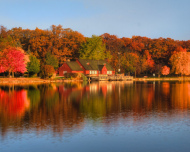
March 2020. Long form.
What makes that huge tome fun is that it includes letters from the American Revolution, the Civil War, first person accounts of hiding in woodpiles to avoid scalping, plus the fun fact that it was actually possible to survive a botched scalping for a time. Our most illustrious ancestor was on my father’s mother’s side, Thomas Macy, who was a member of the nine families who originally purchased Nantucket from Native Americans. Fun fact: Thomas was fined 30 shillings by the Puritans of Massachusetts for providing shelter to Quakers during a rainstorm in 1657. History is full of fun facts like that.
More recently, my family has close connections to Mexico. When I was at Glenbard I found a Congressional Record in our attic from 1846, when Lincoln was a Senator. In it, he argues against the Mexican-American War. I actually wrote a paper about it for history class. Both my parents grew up in Mexico. They met each other at ages 3 and 4. I still have a children’s book that my father gave my mother for her birthday in 1910, when she was four. My mother’s father managed a silver mine there and my father’s father managed a huge 500 square mile cotton plantation that had whole towns and railroad lines running through it.
This is where my family’s history gets really interesting. My parents lived there during the Mexican Revolution. Legend has it that one grandfather narrowly escaped from the banditos by running into the other grandfather’s family compound. But there are more grisly memories. My father was deeply traumatized by the revolution. Routinely, the various revolutionary factions would raid the plantation for food. First Villa, then Zapata would arrive on horseback and my father’s family would flee to the hills, only to return to find their Chinese cooks had been murdered because they would not reveal where the gringos were hiding. Sometimes they were left with only watermelon to eat, because it was too bulky for the horsemen to carry off.
Imagine how my father felt when he was five, and before his nanny could stop him, he ran out into the road to find the various body parts and blood from 250 Chinese that Villa had drawn and quartered the night before, If you don’t know what that term entails, the poor victim is tied to four horses who are driven off in opposite directions. At the age of six he was sent to Texas by train alone to go to school there. The banditos blew up the tracks and shot the engineer and my father was saved by a kind Mexican woman who pretended to be his mother. My father’s parents actually divorced because my grandfather loved Mexico so much that he refused to leave. Apparently he was so reckless that he didn’t even carry a gun.
But the most amazing tale involves my mother’s uncle, Frank, who was rumored to have been held for ransom by Pancho Villa. Frank, who also managed a silver mine, was supposedly kidnapped and held for ransom for gold by Pancho Villa. The story was that the night before the deadline was up, Villa got drunk and apologized to Frank, saying that sadly, his credibility was on the line and that the next day they would have to go “hunting.” Uncle Frank knew what that meant. He would be shot in the back. At dawn the next day, miraculously on the horizon, a lone burro was spotted bearing the requisite gold buillon.
One day I was substitute teaching a high school Spanish class and I regaled them with the colorful story, qualifying it as possibly a tall tale. The next day a sophomore boy came running up to me with a big book entitled REVOLUTION in his hands. “What was your mother’s uncle’s name?,” he asked. “Well,” I answered, “His name was Frank and my mother’s maiden name was Knotts, so it would have been Frank Knotts.”. The boy beamed as he opened his book to an account of the kidnapping and ransom just as I had recounted it.
Just last month, I had told an Hispanic bank officer the story and she had looked at me in disbelief, So I went home and googled “Frank Knotts held for ransom by Pancho Villa.”. Up came four pages in a huge history of Mexico, stating that not only had Frank been held for ransom for $600,000 in gold. He had been able to talk Villa into lowering that amount. But once the donkey with the bullion had arrived, Villa held him longer until $300 worth of flour and sugar was delivered for his banditos.
History is fascinating. It’s just taught the wrong way. It should be taught with original source materials, colorful stories, letters and diaries, a la Ken Burns. For the truth is truly more colorful than memorized dates. In the high school German class I taught I tried to bring World War II alive with original source materials from Jackdaws, a British company that sells packets of reproduced source materials.The packet on the Battle of Britain included enemy aircraft identity cards, handwritten RAF pilot accounts of dogfights with the Luftwaffe, and a copy of the pamphlet that a victorious Hitler planned to drop over Britain to encourage surrender. I’m surprised I wasn’t a history major.
Katherine "Katie" Knowles
Growing up, I longed to have a more colorful background than my family did, which is 100% English. I remember being particularly jealous of one of our classmates (was his last name Caine?) whose ancestors came from the Isle of Mann. My father’s family has traced their roots back to 1623, when John Knowles arrived on Cape Cod. We have a huge book, five inches thick and 18 inches long, that includes all the “begats” since then.What makes that huge tome fun is that it includes letters from the American Revolution, the Civil War, first person accounts of hiding in woodpiles to avoid scalping, plus the fun fact that it was actually possible to survive a botched scalping for a time. Our most illustrious ancestor was on my father’s mother’s side, Thomas Macy, who was a member of the nine families who originally purchased Nantucket from Native Americans. Fun fact: Thomas was fined 30 shillings by the Puritans of Massachusetts for providing shelter to Quakers during a rainstorm in 1657. History is full of fun facts like that.
More recently, my family has close connections to Mexico. When I was at Glenbard I found a Congressional Record in our attic from 1846, when Lincoln was a Senator. In it, he argues against the Mexican-American War. I actually wrote a paper about it for history class. Both my parents grew up in Mexico. They met each other at ages 3 and 4. I still have a children’s book that my father gave my mother for her birthday in 1910, when she was four. My mother’s father managed a silver mine there and my father’s father managed a huge 500 square mile cotton plantation that had whole towns and railroad lines running through it.
This is where my family’s history gets really interesting. My parents lived there during the Mexican Revolution. Legend has it that one grandfather narrowly escaped from the banditos by running into the other grandfather’s family compound. But there are more grisly memories. My father was deeply traumatized by the revolution. Routinely, the various revolutionary factions would raid the plantation for food. First Villa, then Zapata would arrive on horseback and my father’s family would flee to the hills, only to return to find their Chinese cooks had been murdered because they would not reveal where the gringos were hiding. Sometimes they were left with only watermelon to eat, because it was too bulky for the horsemen to carry off.
Imagine how my father felt when he was five, and before his nanny could stop him, he ran out into the road to find the various body parts and blood from 250 Chinese that Villa had drawn and quartered the night before, If you don’t know what that term entails, the poor victim is tied to four horses who are driven off in opposite directions. At the age of six he was sent to Texas by train alone to go to school there. The banditos blew up the tracks and shot the engineer and my father was saved by a kind Mexican woman who pretended to be his mother. My father’s parents actually divorced because my grandfather loved Mexico so much that he refused to leave. Apparently he was so reckless that he didn’t even carry a gun.
But the most amazing tale involves my mother’s uncle, Frank, who was rumored to have been held for ransom by Pancho Villa. Frank, who also managed a silver mine, was supposedly kidnapped and held for ransom for gold by Pancho Villa. The story was that the night before the deadline was up, Villa got drunk and apologized to Frank, saying that sadly, his credibility was on the line and that the next day they would have to go “hunting.” Uncle Frank knew what that meant. He would be shot in the back. At dawn the next day, miraculously on the horizon, a lone burro was spotted bearing the requisite gold buillon.
One day I was substitute teaching a high school Spanish class and I regaled them with the colorful story, qualifying it as possibly a tall tale. The next day a sophomore boy came running up to me with a big book entitled REVOLUTION in his hands. “What was your mother’s uncle’s name?,” he asked. “Well,” I answered, “His name was Frank and my mother’s maiden name was Knotts, so it would have been Frank Knotts.”. The boy beamed as he opened his book to an account of the kidnapping and ransom just as I had recounted it.
Just last month, I had told an Hispanic bank officer the story and she had looked at me in disbelief, So I went home and googled “Frank Knotts held for ransom by Pancho Villa.”. Up came four pages in a huge history of Mexico, stating that not only had Frank been held for ransom for $600,000 in gold. He had been able to talk Villa into lowering that amount. But once the donkey with the bullion had arrived, Villa held him longer until $300 worth of flour and sugar was delivered for his banditos.
History is fascinating. It’s just taught the wrong way. It should be taught with original source materials, colorful stories, letters and diaries, a la Ken Burns. For the truth is truly more colorful than memorized dates. In the high school German class I taught I tried to bring World War II alive with original source materials from Jackdaws, a British company that sells packets of reproduced source materials.The packet on the Battle of Britain included enemy aircraft identity cards, handwritten RAF pilot accounts of dogfights with the Luftwaffe, and a copy of the pamphlet that a victorious Hitler planned to drop over Britain to encourage surrender. I’m surprised I wasn’t a history major.




